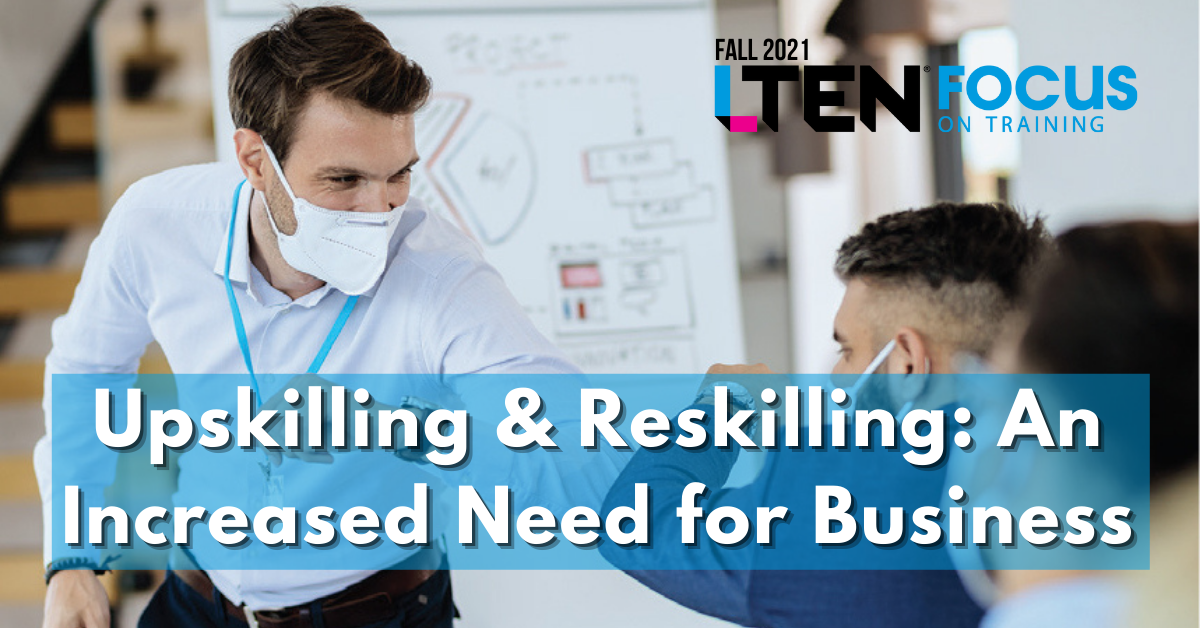
Upskilling & Reskilling: An Increased Need for Business
Feature Story – By Xinyun Peng and William Magagna
How can you implement the processes into your training?
About This Article
Since 2019, LTEN has worked closely with Penn State University as part of our ongoing mission to enhance the quality of learning & development knowledge in the life sciences industry. Through this partnership, LTEN gains access to research, peer-reviewed publications and industry literature, as well as sponsoring a Ph.D. candidate in the PSU program.
This article was created in collaboration with LTEN and PSU to share with members thought leadership and resources to aid their own knowledge and development.
The COVID-19 pandemic has inspired numbers of businesses, from small- and medium-sized to giant companies, across industries, from retail and manufacturing to healthcare, to pivot to a more digital business model to survive. Upskilling and reskilling have been increasingly frequently brought up in the HR lexicon since the start of working-from-home policy. In addition, many recent national reports have emphasized the key role that upskilling and reskilling play in helping workers reengage with the labor market.
What exactly is upskilling and reskilling, and how can those be implemented into your existing training systems?
Upskilling is the process of learning new skills or of teaching workers new skills, and reskilling is the process of learning new skills so you can do a different job, or of training people to do a different job. Since upskilling and reskilling have the core idea in common, they are often discussed together as a pair.
Both upskilling and reskilling require the employee to learn new skills to support their changing job responsibilities. However, the dictionary definitions do not pinpoint exactly the differences between these two concepts. In upskilling, the skills the worker obtained will be able to improve current positions in the same general line of work. In reskilling, the worker learns entirely new skill sets with the goal of transitioning to a new job or even a new field.
 The Drive Has Changed
The Drive Has Changed
Upskilling and reskilling are important to businesses as well as nonprofit organizations all the time, yet the drives for upskilling and reskilling changed after the pandemic, compared to before. Pre-COVID-19, upskilling and reskilling were driven by the rapid evolution of technologies and business models in the Fourth Industrial Revolution (4IR).
The fast-paced technology progress has brought new requirements and hence
changed the existing skills in the labor market. According to the McKinsey report,
as many as 375 million workers globally might have to change occupations in the
next decade to meet companies’ needs. These workers could be replaced by
automation and freed to spend about 30% of their time on new work. Thus,
upskilling and reskilling had become a more essential ingredient to reshape the
workforce.
In a post-COVID-19 era, upskilling and reskilling are taking on new urgency. Since
employers have learned the lesson from the pandemic-led decline in company
performance and hence the downsizing of personnel, upskilling and reskilling
come along at a time when teaching employees new skills is no longer just a nice
thing to offer but a must-do. The pandemic accelerated existing trends in remote work and automation, with up to 25% more workers than previously estimated potentially needing to switch occupations.
In short, upskilling and reskilling are more important than ever before. They have become the most essential ingredient to create the workforce of the future.
 Why More Important Now?
Why More Important Now?
The most straightforward reason is that upskilling and reskilling are more cost-efficient than firing and hiring. Although upskilling/reskilling programs cost money, they provide strong ROI. On one hand, it is easier for current employees to address skills gaps and feel like they are valued. On the other hand, less human and time resources would be allocated to firing and hiring.
When it comes to skills gaps, upskilling and reskilling are less limited, quicker to change and easier to scale, in comparison to school education. Skills gaps are significant gaps between organizations’ current capabilities and the skills they need to achieve their goals and meet customers’ demands.
A Udemy survey based on 263 Learning and Development (L&D) managers and 425 employees and organizations globally shows that 78% of managers’ top priority is to keep employee skills up to speed with change. Yet, in the 2021 Deloitte Global Human Capital Trends survey, only 17% of executives say their workers were ready to adapt and assume new roles in work transformation (optimize, redesign, reimagine work).
Another reason why upskilling and reskilling are important is employees’ motivation. Employed workers need upskilling opportunities to create opportunities for themselves to move up at the company; unemployed workers need reskilling opportunities to find new jobs in areas or sectors that are less impacted by the pandemic. For employers, they need to satisfy this need of workers to acquire and keep talents.
How to Implement Upskilling/Reskilling
Many employers made slow progress to upskill and reskill their employees, which contributes majorly to the dynamics of the current hiring environment. Many surveys regarding current and future workforce trends have shown that organizations are not prepared to provide employees upskilling or reskilling access.
Approximately 56% of 432 survey respondents (HR professionals) said said that moderate to severe skills gaps still exist in their organizations. Organizations are missing the mark on taking effective approaches to upskilling and reskilling. So, when the pandemic hit, while automation and digitalization further accelerated, the consequence of the lack of upskilling and reskilling became even more obvious in many organizations.
The following are some strategies and guidance for planning, designing and implementing upskilling and/or reskilling from different perspectives.
Competency Model
The misconception that needs to be eliminated is that upskilling and reskilling are simply providing employees access to more content. Upskilling and reskilling require an industry-specific competency model to help employees plan and navigate the upskilling/reskilling journey.
A competency model defines the knowledge, skills and behaviors for a set of job roles in a given occupation or industry. Each job role defined in the competency model will have a unique description of the duties, suggested performance criteria and even recommended learning and professional development activities.
In this manner, a competency model provides both the map and compass with which a business and its employees can plan their upskilling/reskilling journeys. Without a competency model, employers tend to measure learning progress in terms of outputs rather than outcomes, and it is difficult to know if any training program is relevant to closing skills gaps.
Four Cs
Continuous upskilling and reskilling not only require a mastery of the fundamental knowledge and skills of your own field but also ask for 21st century interdisciplinary themes, such as global awareness and financial, economic, civic, environmental and health literacy. The Four Cs— creativity and innovation, critical thinking and problem-solving, communication, and collaboration— are critical to intertwining and integrating competencies across disciplines and hence to adapting to a different or emerging work environment. Employers need to shift the mindset to cultivating the Four Cs while designing the training curricula.
Rapid Assessments
The primary objective of rapid assessments of upskilling and reskilling needs is to make organizations and individuals present, active and visible in policy formation when there are other competing priorities. Rapid assessment aims to provide credible and timely reports that can help stakeholders to identify priority areas for actions as well as to mobilize follow-up actions. The assessment consists of four research components:
- Background reading on currently available information relevant to the target sector and group.
- Survey of enterprises in the target sector.
- Survey of individuals in the target group.
- Consultations with key players, such as responsible organizations and policymakers.
After carrying out the surveys and consultations, the training team needs to analyze the data to ensure the accurate identification of the key skills and subsequently develop options for action and implementation that can be deployed shortly. The options should differentiate actions that institutions can undertake independently from initiatives that would need new resources or substantial cooperation.
Platform-Led Upskilling
Platform-led upskilling is training that marketplace platforms provide to suppliers and self-employed workers, outside of an employer-employee relationship. In the era of digitization, moving upskilling to online platforms is well-reasoned. Platform-led upskilling represents a broad spectrum of e-learning, ranging from classrooms that teach digital literacy to massive open online courses (MOOCs), electronic courseware and specialized approaches to mobile learning.
Three general approaches are mostly used in platform-led upskilling: interpersonal training, online training and in-workflow training moments. Besides, some upskilling can occur outside a platform’s control; for example, WhatsApp groups and YouTube tutorials.
Job-To-Be-Done Framework
It essentially says that the behavior of a person “hired” is more situation-driven rather than persona-driven.
In L&D, people are used to developing and marketing learning based on demographics, job types and other descriptive factors. The job-to-be-done framework is applied in L&D to help people consider the unique situations that motivate employees to learn but focus less on who they are.
This framework identifies four key learning moments (unique situations) in the workplace: learning to grow, catch-up, for external change and always learning (life-long learning). Designing training programs with these four learning moments in mind would more precisely support employees to grow in their professional careers.
Bridge-the-Skills-Gap Action Plan
The Association for Talent Development has provided an action plan that shares best practices and ideas that practitioners and leaders can use to identify and address skills gaps and therefore to keep their organizations competitive. Here are the key steps to take when it comes to assessing and closing the gaps:
- Step 1: Clarify and understand the organization’s performance metrics.
- Step 2: Identify competencies and skills that map to strategies and performance metrics.
- Step 3: Assess the skills gap.
- Step 4: Set goals and prioritize the path to filling gaps.
- Step 5: Implement solutions and monitor sustainability.
- Step 6: Communicate the impact.
Strategies for a Sustained Recovery
Washington Student Achievement Council has provided short-term and long-term strategies and suggestions for recovering from the recession through upskilling/reskilling. In the short term, organizations should:
- Expand communication efforts to improve public awareness about the range of available non-degree programs that provide qualifications for jobs that can advance their careers.
- Continue to provide broad access to online courses as higher education returns to in-person mode.
- Ensure the support services available for people who face barriers to attending in training programs.
- Expand the application of certificates and learning programs, so that unemployed workers, for example, would be able to quickly obtain credentials to qualify for a new job.
In the long term, two strategies are recommended:
- Continue to develop the range of certificate programs that are stackable toward degrees in seamless credential pathways.
- Extend the availability of credential pathways to people who have been hardest hit by the employment decline. By these means, more people will benefit from upskilling and reskilling in a longer period.
Key Takeaways
In the post-COVID time, organizations and their L&D systems need to be even more agile and innovative than pre-COVID time to keep pace with the accelerating rate of change.
Upskilling and reskilling are a way to keep employees and therefore the organization agile. Upskilling allows workers to gain skills to improve in the same general line of work, whereas reskilling aims to equip workers to learn entirely new skills sets toward a new job or field.
It has always been crucial for organizations to remain vital and dynamic, before and after the pandemic. However, the drive to upskill and reskill employees changed from technological development and automation to the unpredictable global environment change. For individuals, before, employees needed to feel room for improvement to be motivated. Now, they tend to stay relevant to the field and not to be eliminated.
Xinyun Peng is a graduate research fellow at Penn State University. Email Xinyun at xypeng@psu.edu. William Magagna is global head, customer solutions EDU digital and infrastructure, Siemens Healthcare, and treasurer of the LTEN Board of Directors. Email Bill at william.magagna@siemens.com.
For More Information
A great amount of literature has contributed insights regarding implementing upskilling and reskilling to both the corporate and academic fields, and these insights can be generalized into the following ideas:
- Providing regular training programs that are easily accessed and microcredential based.
- Employees take the ownership of learning toward upskilling and reskilling. Informal learning opportunities, e.g., lunch & learn training sessions, mentoring and shadowing.
- Customizing rather than standardizing training and learning to meet emerging needs.
- Identifying key learning moments will enhance the efficiency and effectiveness of training.
- Technology platforms can reduce skill mismatches.
- Technical/vocational training and learning requires a public-private partnership.
All the mentioned literature is listed below, please feel free to read further. Keep in mind that not all the strategies and models are perfectly aligned with each other and based on the same paradigm, yet you can get inspiration from the ones that fit your needs and integrate them into your existing frameworks.
Association for Talent Development. (2018). Bridging the skills gap. Journal of Chemical Information and Modeling.
Association of Community College Trustees. (2020). Reskilling for the pandemic recession and recovery.
Chakma, S., & Chaijinda, N. (2020). Importance of reskilling and upskilling the workforce. Interdisciplinary Sripatum Chonburi Journal, 6(August), 1–9. Degreed. (2019). The innovator’s guide to emerging skills.
Degreed. (2019). The innovator’s guide to emerging skills.
Deloitte. (2021). Deloitte Insights – The social enterprise in a world disrupted. Deloitte Insights.
Dickson, K. E., Johnston, N. E., Mcmillan, H. S., & Schwieger, D. (2021).
Development of a flexible point-based promotion and tenure document in the age of societal uncertainty. (April).
Donner, J., Dean, M., Osborn, J., & Schiff, A. (2020). Platform-led upskilling: Marketplace platforms as a source of livelihoods training. ACM International Conference Proceeding Series. https://doi.org/10.1145/3392561.3394629
Gulati, Manas. (2018) Why re-skilling is the most important ingredient to create the workforce of the future. https://www.peoplematters.in/article/skilling/why-re-skilling-is-themost-important-ingredient-to-create-the-workforce-of-the-future-19251
Half, R. (2018) The Importance of Upskilling Your Employees. https://www.roberthalf.com/blog/management-tips/the-importance-of-upskilling-youremployees
ILO (International Labour Organization). (2020). Guidelines on rapid assessment of reskilling and upskilling needs in response to the COVID-19 crisis.
Jagger, P. D. (2020). Digital upskilling during the pandemic.
Lederer, A. L., & Mendelow, A. L. (1986). Issues in information systems planning.
Information and Management, 10(5), 245–254. https://doi.org/10.1016
/0378-7206(86)90027-3
McKinsey & Company (2020) Beyond hiring: How companies are reskilling to address talent gaps. https://www.mckinsey.com/business-functions/organization/ourinsights/beyond-hiring-how-companies-are-reskilling-to-address-talent-gaps
McKinsey & Company. (2021). The future of capability building. (February). https://www.mckinsey.com/featured-insights/the-next-normal/capability-building
Mgiba, F. (2019). Merger, upskilling, and reskilling of the sales – marketing personnel in the fourth industrial revolution environment. 19(5).
Monear, B. D. (2020). Strategies for a changing labor market: Reskilling and upskilling for career advancement in the post-COVID-19 economy. (October).
Pavlova, M. (2020). Anticipating and preparing for emerging skills and jobs. Retrieved from http://www.springer.com/series/5888
Saha, S. (2020). Cultural alignment: The fundamental fuel for business success –
an HR perspective from the pharmaceutical industry. NHRD Network Journal, 13(2), 129–132. https://doi.org/10.1177/2631454120930527
Sivalingam, A. D., & Mansori, S. (2020). How organizations should view reskilling
and upskilling the workforce. SASTRA Education Development.
Udemy for Business. (2019). What motivates employees to learn.








